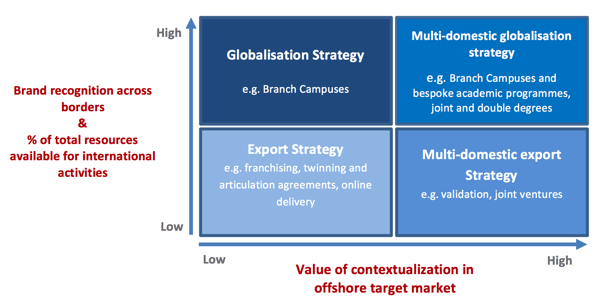Published on
The Competitive International Higher Education Marketplace: Identifying Business Strategies to Succeed (Part 2)

This is the conclusion of Dr. Vangelis Tsiligiris’s two-part series exploring the importance of an international business strategy for the modern higher education institution. In the first part, Dr. Tsiligiris outlined the three major forces impacting the competitiveness of today’s higher education marketplace: declining public funding, falling international student mobility and fierce domestic and global competition. In this conclusion, he shares his thoughts on how a robust international business strategy and a nimble approach to the marketplace can help institutions develop the alternate revenue streams central to competing in this space.
Universities have traditionally pursued international activities as a result of individual academic and executive staff members’ links and initiative, in the context of cultural and language links and in pursuit of short-term financial goals.
However, successful international activities require careful planning, dedication of resources and constant re-alignment to conditions of the fast-changing international higher education market.
In the context of an international business strategy, universities should consider their brand recognition across borders and the size of resources available for international activities. Universities that are not recognizable outside their national borders will find it difficult to pursue a global strategy by simply entering an offshore higher education market and basing their strategy on covering the gap in supply. Additionally, the size of available resources to support international activities will be a critical factor for the identification of the appropriate international strategy mode a university will be able to pursue. For example, universities that can’t dedicate substantial resources to support international activities are unlikely to be able to sustain a physical presence in an offshore market.
Also, different target offshore markets will require different responses in relation to the degree of contextualisation of the academic programmes offered. This is because, in offshore markets, different stakeholders (most importantly students and employers) place differing value on academic programs offered by foreign universities. This relative valuation determines the type of transnational education activities and arrangements a university can pursue and whether contextualisation of academic programs will be required.

Universities that have a strong global brand reputation and significant resources at their disposal can pursue a “globalization” or a “multi-domestic globalization” strategy (as outlined in the image above). Setting up branch campuses in offshore markets and collaborating with local universities to deliver double and joint degrees will allow institutions to reach students in their home countries and hedge against the declining outbound student market at an early stage.
On the other hand, universities that lack global reputation and brand recognition outside national borders will need to pursue an “export” or “multi-domestic” strategy. These institutions can enter an offshore higher education market specifically to fill an existing educational supply gap through franchising, validation and online delivery. At a later stage, when the market has reached equilibrium between supply and demand, these institutions can capture part of the market through twinning (partnership) or/and articulation agreements with local providers. When the market reaches the point where contextualization is valued, validation of locally-developed programs and joint ventures with local higher education institutions will become appropriate.
Overall, higher education institutions are facing increased competition and changing market conditions. Universities can use the range of international strategies discussed above to plan their response to the challenges ahead and secure a sustainable future development.
Author Perspective: Administrator




